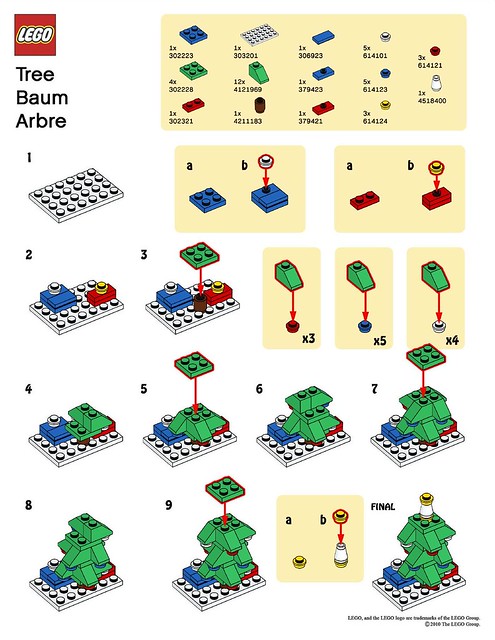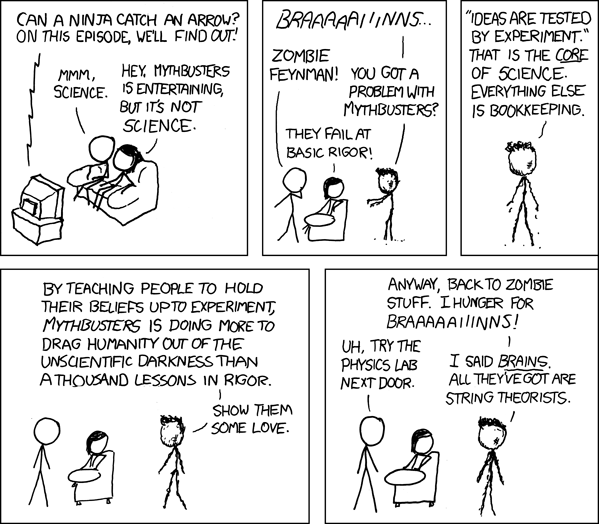
(Image credit: toomuchdew on Flickr)
When I was a kid, I had a lot of Lego, most of which was given to me as birthday gifts, and came in nice neat boxes with instructions on how to build whatever was on the picture on the outside of the box. I would often follow the instructions carefully once, to make sure I could create the picture, and then that package of Lego joined the big bucket of Lego, and I never assembled that particular design again. I did spend a lot of time creating my own models, and learning different ways of putting the pieces together myself. I remember better the things I created than the things I assembled. 25 years later, I still remember when I used all of my Lego to create a sprawling metropolis on my floor.
My son and I play Lego together, and just like when I was a child, he wants to follow the directions. We’ve built a couple of things together that way, but we’ve also spent hours upon hours making our own designs. Recently, we’ve been constructing sling-shots with our Lego along with some rubber bands, and then using these to fire smaller pieces of Lego at targets. My son calls this "playing Angry birds." In this case, we’ve had a design (the Angry Birds slingshot) and we’ve reverse engineered a way to create this slingshot with Lego.
We need to be careful that we give students time for creation, which I see as a much different process than assembly. Creation helps kids develop entrepreneurial skills, use their imagination, and allows them to be inventors. Assembly allows them to learn how to follow instructions, and work toward a well established goal. There is also a middle ground between the two, which I call reverse engineering where you give students the final outcome, and they have to work to figure out how it was built.
When you assign a project and give students a highly structured way of completing the project, you are having them assemble their project, rather than create it. They may not be assembling pieces of Lego, but it is a form of assembly nonetheless. These kinds of projects can be valuable for your students, and can help focus students on the final product of the project but the more information you give students on what their project should look like, or how they should go about doing it, the less freedom they have to actually be creative.
There is research which shows that when kids are shown how to do something (as what happens when you give them a set of instructions to follow), they are less likely to "engage in spontaneous exploration and discovery" (Thanks to @jybuell and @andymikula for sharing those two links). We must then be very careful about our purpose in giving kids a set of instructions to follow, given that we may be shutting down some of their creative capacity in this area.
There are types of tasks for which instructions are pretty important. You can’t write a high quality academic paper without reading examples of other academic papers, and without some pretty careful instructions on formating. The language of academic papers is highly specialized and often cryptic.
However, I don’t want my son writing academic papers just yet. He’s young. I want him to explore the world, and see what is possible, and use his imagination as much as he can at this young age (thanks @allanalach for this link). He has plenty of time to learn about the dydactic academic world later. For now, I want him to play.
A subject like science, for example, can very much be taught either as an act of creation, or as an act of assembly. Give students all of the instructions on how to complete a lab, and they are assembling a lab. Give them a goal (figure out why this phenomena works) and they are reverse engineering. Give students time to play (safely) with the tools in a laboratory and come up with their own experiments, and they are creating.
Scientific inquiry is about asking questions and exploring the answers to those questions through experimentation. If we want kids to think like scientists, we need to give them the ability and option to experiment. As this comic suggests, the core of science is that ideas are tested by experiment, and that everything else is just bookkeeping.

Let’s make sure that our need for bookkeeping doesn’t disrupt our kids need for exploration. Let’s make sure we give kids lots of time to be creators, and not have them just assemble stuff.
Evan Weinberg says:
I agree with your point – we need to make sure students are not just “assembling” solutions to equations, simplified forms of expressions, etc. The analogy continues in explaining why math algorithms are the reverse of what we should be teaching students in the context of 21st century skills. We are not training kids to be cogs in a factory, so they should not all be taught to do exactly the same thing in exactly the same way with little actual problem solving skill development aside from superficial ‘why’ questions. We should be giving students time to figure things out, to play with content however possible using available tools, in order to construct meaning, understanding, or an application of the content.
Your analogy, however, points to something else that I learned using LEGO during my engineering classes at college. I did play a lot with LEGO before the technics era, picking it back up at a robotics elective class at Tufts with Chris Rogers. I was a bit of a purist at that point and thought I needed to figure out the best use of the materials without looking things up or looking at other designs. Needless to say, these designs were not great. It was only after backing off this philosophy and following some of those instructions that I learned how to use the newer pieces LEGO had brilliantly created to expand the capabilities of its builders. Without that direct instruction, It is doubtful I would have figured it out. Later when FLL students would ask how I got good at building robots, I would tell them I got better when I took the time to learn how to do it the wrong way so many times and then worked with people more experienced to get better ideas of how to use the tools.
I think balance between skill development and application is the key. Students may not see the immediate benefit to learning a skill, but you as a teacher know that without that skill, a student will only be able to solve an upcoming problem by trial and error. That works for some problems, but is exhausting for others. Modeling a structure (but not the entire structure) for design can help a weaker student find a way in to a creative design problem. On the other hand, you never really know what intuition a student can develop from playing around and creating in an environment or using a tool that is structured in a way to be conducive to learning. As you and I have previously discussed, Geogebra is my environment of choice. Having opportunities for both is the most important thing for nurturing kids to be more than followers of steps and for creating classrooms that develop flexible thinkers.
September 28, 2011 — 3:03 am
Emily Sheridan says:
Hi David, I couldn’t agree with you (and Zombie Feynman) more. I completely believe that discovery and exploration are the key to not only creating a deeper understanding for students (particularly in the areas of math and science) but also to making these subjects fun! I think it’s so fantastic that your son enjoys following the LEGO instructions as well as creating something on his own.
Emily
September 28, 2011 — 7:41 pm